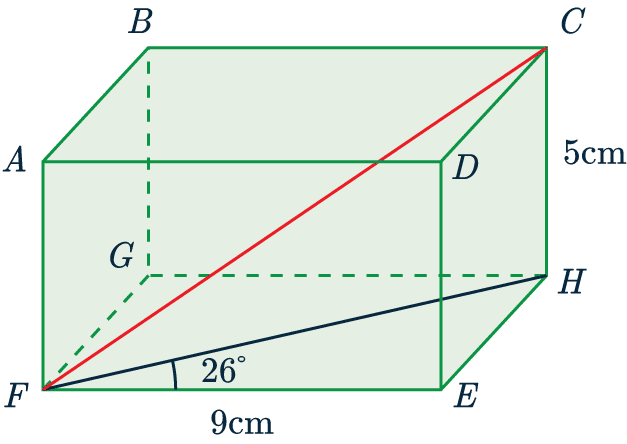3D Pythagoras and Trigonometry
3D Pythagoras and Trigonometry Revision
3D Pythagoras and Trigonometry
3D Pythagoras and Trigonometry is just adding a 3rd dimension.
First lets recap the basics.
Pythagoras’ Theorem.
\textcolor{red}{a}^2 + \textcolor{limegreen}{b}^2 = \textcolor{blue}{c}^2,
Secondly, trigonometry and SOHCAHTOA.
\sin(x) = \dfrac{O}{H}, \,\, \cos(x) = \dfrac{A}{H}, \,\, \tan(x) = \dfrac{O}{A}
Make sure you are happy with these topics before continuing
3D Pythagoras
For 3D Pythagoras, there is a new equation we can use, which just uses Pythagoras’ theorem twice.
In the diagram shown, find the length of \textcolor{red}{d}
[3 marks]

We already know that,
Equation 1:
\textcolor{limegreen}{a}^2 + \textcolor{orange}{b}^2 = \textcolor{black}{e}^2
and we can see that edc also forms a right angled triangle so we know,
Equation 2:
\textcolor{black}{e}^2 + \textcolor{blue}{c}^2 =\textcolor{red}{d}^2
So this means we can combine equation 1 and 2, to give our 3D Pythagoras equation.
\textcolor{limegreen}{a}^2 + \textcolor{orange}{b}^2 +\textcolor{blue}{c}^2 =\textcolor{red}{d}^2
3D Trigonometry
With 3D Trigonometry, there is no trick, you need to solve each section in steps which makes it a harder topic.
Example: Shape ABCDEFG is a cuboid.
[3 marks]
Find the length of side FC, marked in red, to 3 sf.

Firstly, the shape is a cuboid, which means every corner is a right-angle.
First what we need to do is find FH, this will give us the base of the right-angled triangle FHC, which will let us find FC.

To find side-length FH, we need to use trigonometry
Adjacent FE=9\text{ cm}
Hypotenuse =x
This means we will be using ‘CAH‘

\cos(26) = \dfrac{\text{Adjacent}}{\text{Hypotenuse}} = \dfrac{9}{FH}
FH \times \cos(26) = 9
FH = 9 \div \cos(26) = 10.013… cm
Now we know FH, our first triangle, FCH, looks like this:

Now, we know two side-lengths of this triangle, we can use Pythagoras’ theorem to find the third, FC, which is the answer to the whole question.
(FC)^2 = 5^2 + (10.013…)^2
FC = \sqrt{5^{2} + (10.013…)^{2}} = 11.2 cm (3 sf).
3D Pythagoras and Trigonometry Example Questions
Question 1: ABCDE is a square-based pyramid. The apex of the pyramid, E, is directly over the centre of the base.
Calculate the perpendicular height of the pyramid. Leave your answer in surd form.
[3 marks]

If we draw a line from the apex at E down to the centre of the base, then that line represents the perpendicular height, since we know the apex is directly above the centre. Consider the triangle formed by this line, the line which goes from the centre to C, and the line EC.

We know the hypotenuse, but we need further information. Here, we observe the distance from the centre to C is half the distance from A to C. Given that we know the width of the square-based triangle, we can find the length of AC, halve it, and then use the result as a part of Pythagoras’ theorem to find the perpendicular height.
For finding AC, consider the triangle ABC.

Therefore, the distance from the centre of the base to C is 5\sqrt{2}. Finally, we consider again the first triangle, which we now know has base of 5\sqrt{2} cm, and calculate the perpendicular height.
12^2 = (\text{HEIGHT})^2 + (5\sqrt{2})^2
(\text{HEIGHT})^2 = 12^2 - (5\sqrt{2})^2 = 144 - 50 = 94
\text{HEIGHT } = \sqrt{94} cm.
Question 2: The cuboid shown in the diagram below has the dimensions: 9 cm by 6 cm by 12 cm.
CY = 6 cm
Find the length of the line AY.
Leave your answer in surd form.
[2 marks]

Here we use 3D Pythagoras to find that AY is
AY^2 =9^2 + 6^2+6^2
AY =\sqrt{81+36+36}=\sqrt{153}=3\sqrt{17} cm.
Question 3: The cuboid shown in the diagram below has the dimensions: 9 cm by 6 cm by 12 cm.
Find the length of the diagonal line CE. Leave your answer in surd form.
[2 marks]

Here we use 3D Pythagoras to find that CE is
CE^2 =9^2 + 6^2+12^2
CE =\sqrt{81+36+144}=\sqrt{261}=3\sqrt{29} cm.
Question 4: ABCDE is a square-based pyramid. The apex of the pyramid, E, is directly over the centre of the base. Calculate the angle EDB. Give your answer to 1 decimal place.
[3 marks]

First of all, we can work out the length of DB by Pythagoras or by recognizing that the diagonal of a square is \sqrt{2} \times \text{ side length}, thus:
DB=14\sqrt{2}
Hence the length from D to the centre of the square, O, is half this value
DO=7\sqrt{2}
Now we have enough information to find the required angle,
\tan(EDB) = \dfrac{O}{A} = \dfrac{11}{7\sqrt{2}}=
\text{Angle} \, EDB = tan^{-1} \bigg( \dfrac{11}{7\sqrt{2}} \bigg)=48.0\degree
3D Pythagoras and Trigonometry Worksheet and Example Questions
(NEW) MME 3D Pythagoras and Trigonometry Exam Style Questions - MME
Level 6-7Level 8-9GCSENewOfficial MME3D Pythagoras and Trigonometry Drill Questions
Pythagoras In 3d
Level 6-7GCSE
MME Premium Membership
£19.99
/monthLearn an entire GCSE course for maths, English and science on the most comprehensive online learning platform. With revision explainer videos & notes, practice questions, topic tests and full mock exams for each topic on every course, it’s easy to Learn and Revise with the MME Learning Portal.
Sign Up Now




